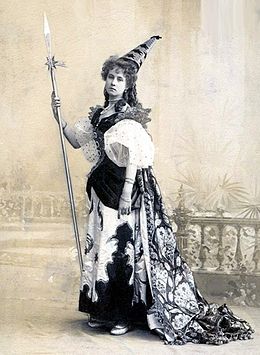Barbe-Bleue (ballet)
| Barbe-bleue | |
|---|---|

Olga Leonova costumed as the Spirit of Curiosity in Petipa's Bluebeard. St. Petersburg, 1896.
|
|
| Choreographer | Marius Petipa |
| Music | Pyotr Schenk |
| Libretto | Countess Lydia Pashkova |
| Based on | Charles Perrault's Bluebeard |
| Premiere | December 20 [O.S. December 8] 1896 Imperial Mariinsky Theatre, St. Petersburg |
| Design |
Pyotr Lambin Konstantin Ivanov Heinrich Levogt (act III/scene 2 & apotheosis) |
| Created for | Marius Petipa's 50th anniversary in service to the St. Petersburg Imperial Theatres |
| Type | Ballet-féerie |
Pyotr Lambin
(act I)
Konstantin Ivanov
(act II/scene 1, act III/scene 1)
Heinrich Levogt
(act II/scenes 2, 3 & 4)
Barbe-bleue (en. Bluebeard) (ru. «Синяя борода», Sinjaja boroda) is a ballet-féerie in three acts and seven scenes, originally choreographed by Marius Petipa to the music of Pyotr Schenk. The libretto was created by the author and dramatist Countess Lydia Pashkova from the fairy tale Bluebeard by Charles Perrault. The ballet was first presented by the Imperial Ballet on December 20 [O.S. December 8] 1896 at the Imperial Mariinsky Theatre in St. Petersburg, Russia, the first performance being a benefit in honor of Marius Petipa's fiftieth anniversary in service to the St. Petersburg Imperial Theatres.
Marius Petipa created the ballet Bluebeard for his own benefit performance given in honor of his 50th anniversary of service to the St. Petersburg Imperial Theatres. The ballet was given a lavish production of the most sumptuous costumes and décor, with the Mariinsky Theatre's machinists creating complex and rapid stage metamorphoses. Many critics who attended the ballet's premier complained that Bluebeard sacrificed plot and artistic sensibilities in favor of spectacle, with the libretto merely serving as an excuse for elaborate stage transformations and even more elaborate dances. Nevertheless, Petipa's dances for Bluebeard were universally hailed as masterworks of classical choreography. The critic from the St. Petersburg Gazette commented on the danced numbers in Bluebeard:
...(Petipa) shows an endless variety and taste, with his work for the corps de ballet being masterfully executed. This year the ballet master celebrates his 50th year of service to our theatre, demonstrating once again that no one in Europe can claim to be his rival.
Although the ballet was a great success during its opening run, Bluebeard did not find a permamnent place in the repertory of the Imperial Ballet, and by the turn-of-the-20th century it has disappeared altogether from Mariinsky Theatre. On 1910 the danseur and pedagogue Nikolai Legat mounted a revival of Bluebeard in St. Petersburg. As with its original inception in 1896, the first performances of Legat's revival of Bluebeard were successful but the ballet did not long survive, and was performed for the last time in 1916.
...
Wikipedia
